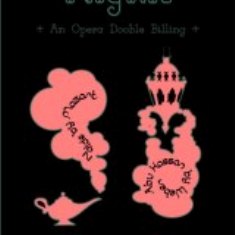
"Arabian Nights" Double Bill a Treasure

|
That is, if you haven’t heard Queen City Chamber Opera.
Co-founded by Isaac Selya and François Lopez, the company debuted in June, 2012 with Mozart’s “Der Schauspieldirektor” and “Bastien et Bastienne” (see review at http://www.musicincincinnati.com/site/reviews/Projekt_Wolfgang_Auspicious_in_Chamber_Opera_Company_Debut.html).
They returned Saturday and Sunday with Mozart’s “Zaide” in an “Arabian Nights” double bill with Carl Maria von Weber’s “Abu Hassan.” The performance (this reviewer attended on Sunday) in the Cincinnati Art Museum auditorium was as loveable as it gets – and as admirable, for it demonstrated how to make the most of limited resources.
The music was tops, with a cast of singers drawn from the University of Cincinnati College-Conservatory of Music’s formidable reservoir of students and alumni(ae), as was the orchestra. Selya, a doctoral candidate in conducting at CCM, led both performances.
Stage direction was by tenor Dashiell Waterbury, who also sang leading roles in both operas. Art direction was by James Schenck, with set design, costumes and lighting by FORSUM, a newly formed Cincinnati-based art collective specializing in event-based installations (visit them at www.facebook.com/4orsum).
The sum total of their efforts was creativity unlimited.
Stroke of genius number one was tying the two operas together. Mozart’s “Zaide” was left unfinished, lacking both an overture and a final (third) act. Weber’s one-act “Abu Hassan” is based on a tale from the Arabian Nights.
Here’s how the stitching was done:
Zaide and Gomatz, protagonists in “Zaide,” are slaves of Sultan Soliman (Zaide is his favorite slave girl). With the aid of the Sultan’s head guard, Allazim, who also desires freedom, the three are apprehended trying to escape. Act II ends with the Sultan threatening execution, goaded by Osmin, a guard who desires Allazim’s job. No one knows how Mozart would have ended it, though it is considered a study for his later opera “The Abduction from the Seraglio,” which has a happy, love-conquers-all ending.
As knit together by QCCO, the attempted escapees from “Zaide” are alive and well in Weber’s opera, presumably having been freed by the Sultan, who is now Caliph Soliman. Gomatz, now known as Abu Hassan, has taken a wife, Fatime, but they have fallen into debt. They hatch a plot to get money from the Caliph by announcing their deaths and collecting funeral expenses (a Muslim custom). Osmin, who is now Omar and money changer to Soliman, has romantic designs on Fatime and offers to pay their debts in exchange for her favors, which she pretends to accept. The Caliph discovers they are not dead, but he forgives them anyway, while punishing Omar for immorality.
It worked beautifully. Maximizing the connection is the fact that Weber was strongly influenced by Mozart and the two men were related (by marriage, through Mozart’s wife Constanza Weber). Coincidentally, Sunday was Mozart’s 257th birthday – and Selya’s 27th – making it party time for all.
Both operas are Singspiel,
i.e. light opera with spoken dialogue. The arias and ensembles were sung in
German, with English surtitles, the spoken portions in English. The action transpired on a raised platform
behind the orchestra, which occupied the front of the stage (24 musicians, plus
Selya). The set was simplicity itself, a
wall the left to divide the action into spaces, a panel in the center onto
which the English surtitles (by Rafael de Acha) were projected and a large wooden
box, which served as a divan, a bed and in “Abu Hassan,” a hiding place for
Omar. and a stool that was a chair and a potential chopping block.
Props were large cutouts, a knife, scimitar and drinking vessels (the weapons painted bright orange), a wooden stool that served as a chair and in "Zaide," a potential chopping block, and some toss pillows for “Abu Hassan.” The costumes were Arabic-looking, with colorful caps for the men and scarves for the women. Soprano Lauren Pollock-Cohen sang Zaide, delivering her “Ruhe sanft, mein holdes Leben” (“Rest in peace, my sweet life”) with affecting sweetness, while Waterbury’s light lyric tenor rang out in Gomatz’s hopeful “Rase Schicksal” (“Rage fate”). Baritone Conor McDonald (a good guy even if he is the Sultan's head man) conveyed both authority and empathy in "Nur mutig,mein Herze" ("Only brave, my heart"). Tenor Daniel Ross as the Sultan railed menacingly, nevertheless, over his betrayal by Zaide, who chooses a slave over a Sultan, in his act II aria,“Ich bin so bös als gut” (“I am both good and cruel”). Then there was baritone Christopher Brandon Morales as Osmin to egg him on wickedly in “Wer hungrig bei der Tafel sitzt” (“Who sits hungry by the table”).
Waterbury and soprano MeghanTarkington were well matched, both vocally and dramatically, as Abu Hassan and Fatime. She flirted hilariously with the amorous Omar (Morales), who hid in the box to avoid detection when Abu Hassan returned home, and both teased him mercilessly as he poked his head out now and then. Things grew downright riotous when Soliman and Zaide arrived to check on Abu Hassan and Fatime’s welfare (living or dead?), and both faked death and resurrection, drawing helpless laughter from the audience.
Selya and the orchestra performed splendidly. Ensemble was keen and on target, and there were some lovely solo moments for principal players, notably bassoon and cello. Guitarists James Meade and Patrick Meade became part of the action in “Abu Hassan” when they performed onstage with Waterbury in Abu Hassan’s aria “O Fatime. Meine Traute” (“O Fatime, my dear”). The Overture to “Abu Hassan” was memorable for its zip and verve -- and for this listener, its uncanny resemblance to the finale of Beethoven’s String Quartet, Op. 18, No. 4, which pre-dated it.
With two highly successful production to its credit, Queen City Chamber Opera is well on its way to becoming a Cincinnati treasure.